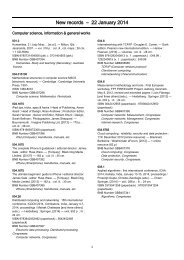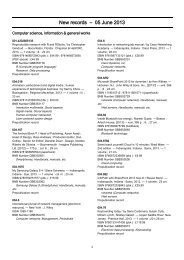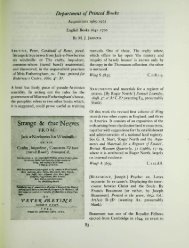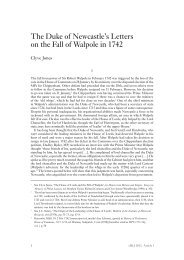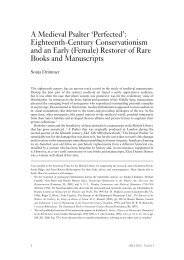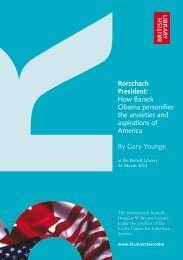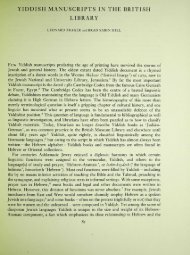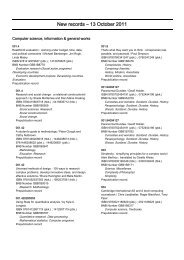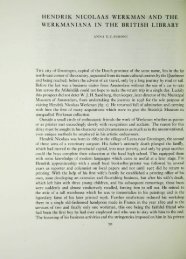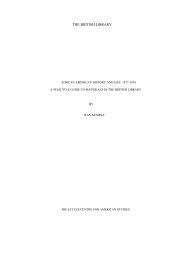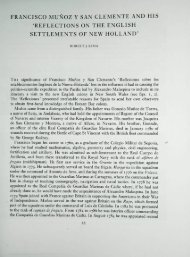SIR WILLIAM MUSGRAVE AND BRITISH BIOGRAPHY - British Library
SIR WILLIAM MUSGRAVE AND BRITISH BIOGRAPHY - British Library
SIR WILLIAM MUSGRAVE AND BRITISH BIOGRAPHY - British Library
Create successful ePaper yourself
Turn your PDF publications into a flip-book with our unique Google optimized e-Paper software.
<strong>SIR</strong> <strong>WILLIAM</strong> <strong>MUSGRAVE</strong> <strong>AND</strong> <strong>BRITISH</strong><br />
<strong>BIOGRAPHY</strong><br />
ANTONY GRIFFITHS<br />
THE Gentleman^s Magazine carried for 3 January 1800 the following obituary: 'At his<br />
house in Park-place, St. James's, Sir W[il]ia]m Musgrave, bart. V.P.R.S. and F.A.S., a<br />
trustee of the <strong>British</strong> Museum, formerly a commissioner of his Majesty's customs, and<br />
afterwards an auditor of the public accompts; in both which situations he had exerted<br />
himself with ability and attention. Nor was he less conversant in the several branches of<br />
Hterature and science; and, though for many years suffering great infirmities of body, his<br />
mind continued unshaken; and, with the practice of the philosophy he had acquired, he<br />
united these talents and manners that rendered his society coveted, and will occasion his<br />
death to be generally lamented. His large collection of engraved portraits was advertised<br />
for sale by auction just before his death.'^ This obituary is unenthusiastic and fairly<br />
uninformative, as if the writer knew little about his subject. This was almost certainly<br />
the case, for Musgrave was far from a public figure. He never became the subject of an<br />
entry in the Dictionary of National Biography, and the few printed accounts of his life<br />
suggest that there was little more to it than that of a successful civil servant with scholarsinterests.<br />
William Betham, in his Baronetage of England, gives the information that his<br />
baronetage was inherited, and that he was 'baptised at Aspatria 8 October 1735, entered<br />
the Middle Temple 7 April 1753, called to the bar 1758 (and subsequently a bencher<br />
25 May 1789, Reader, and in 1795 Treasurer of the Middle Temple); appointed a<br />
commissioner for customs 15 May 1763; FRS 1774; FAS 1777; vice-president of the<br />
Royal Society 1780; trustee of the <strong>British</strong> Museum 1783; vice-president of the<br />
Antiquarian Society January 1786; a commissioner for auditing the public accounts Tulv<br />
1785"<br />
Musgrave's own publications are almost non-existent. The General Catalogue of the<br />
<strong>British</strong> <strong>Library</strong> credits him with one book, A Collection of all the Statutes now in force<br />
relating to the Revenue and officers of the Customs, a large quarto of 1586 pages plus 209<br />
pages of index, published in two volumes in 1780, in which all the statutes from the<br />
Middle Ages to the present are reprinted verbatim in chronological order, with no<br />
commentary, and no mention of Musgrave's name anywhere.^ As a member of the<br />
Society of Antiquaries, he contributed only one paper read on 16 February 1797, a copy<br />
of an original manuscript entitled ' Instructions for every centioner to observe duringe<br />
the continuance of the Frenche Fleet uppon this cost untill knowlege shal be had of ther<br />
171
disperccment, given by Sir George Carye, Captain, this fyrst of September 1586'. This<br />
was of topical interest when given during the invasion scare of 1797, but less so when<br />
eventually published in Archaeologia in 1800.* As a member of the Royal Society, he<br />
never contributed to its Philosophical Transactions.^<br />
Although crippled by ill-health** and an excessive modesty, Musgrave was,<br />
nevertheless, one of the foremost antiquarians of his day, and compiled pioneering<br />
collections, which all focused on his central interest in <strong>British</strong> biography. These were<br />
made freely available to his contemporaries, and served as the basis for much scholarship<br />
of the time. Sections of his library retain their importance to the present day. His<br />
interests covered printed books, prints, autographs, and manuscripts. It is the purpose<br />
of this paper to gather information together about these collections, and hence to<br />
establish the comprehensive and indeed professional way in which Musgrave went about<br />
his amateur interest.<br />
The chief surviving parts of his collection are now in the <strong>British</strong> <strong>Library</strong>, and it is<br />
therefore Musgrave's life as a Trustee of the <strong>British</strong> Museum that is the starting point<br />
of this enquiry. He was elected Trustee on 23 January 1783 in the place of the late<br />
Charles Gray; the other Trustee elected on the same day was Sir William Hamilton.'' On<br />
11 lune the following year the Rev. Clayton Mordaunt Cracherode joined them on the<br />
board. Musgrave was assiduous in his attendance both at the General Meetings, and at<br />
the more frequent Committees when the real business of the Trustees was done. The<br />
minutes are unfortunately too brief to reveal what particular contributions he made to<br />
their deliberations; we know only the decisions that were finally taken. Thus he was<br />
present when it was agreed that 'such historical books as are not in the house be bought<br />
at reasonable prices at Mr Gulston's sale', but whether he spoke in favour we do not<br />
know. The only Trustee of the period who clearly did concern himself actively in the<br />
day-to-day activities of the Museum was Sir Joseph Banks.<br />
The first record of Sir William Musgrave as donor to the Museum occurs in#'i79O,<br />
when he was thanked on 13 August for presenting 400 books; no indication is given as<br />
to what they were.^ On 11 January 1799 he presented two French copper coins 'of the<br />
type now in circulation'; five months later on 7 June, Planta, the principal librarian, was<br />
instructed to pay him £9 6s for a choice copy of Harding's Shakespeare illustrated by<br />
engravings which he had purchased for the use of the Museum. At the same time,<br />
Musgrave presented 'several catalogues of painted portraits in many of the public<br />
buildings and capital mansions of England and Scotland together with a writ of privy seal<br />
of King Charles I'.<br />
On II May 1799 the death of Cracherode was announced to the Trustees, and the<br />
news of the bequest of his library and collection of prints and drawings. They then<br />
resolved that' the present Committee Room be properly fitted up and secured with wire<br />
book cases for the reception of the books and prints' of the bequest, and on 13 July<br />
decided that 'six cabinets of the construction recommended by Sir William Musgrave for<br />
the securing properly Mr Cracherode's collection of prints be put in hand immediately'.<br />
Musgrave made a further gift on 4 October 1799 of'a large collection of manuscripts<br />
172
Fig. I. Sir William Musgrave; portrait by Lemuel Francis Abbott<br />
173
elating to the court and public affairs of this kingdom'. This can readily be identified<br />
with Add. MSS. 5750-5756, seven volumes which contain a collection of original<br />
warrants, the contents of which are fully listed in the manuscript catalogue of Additional<br />
Manuscripts. This gift was soon subsumed in the bequest received at the beginning of<br />
1800. The relevant passage in Musgrave's will, dated 6 July 1799, reads thus: 'I do give<br />
and bequeath to the Trustees for the time being of the <strong>British</strong> Museum upon trust<br />
nevertheless to and for the use of the public my collection of autographs and my<br />
manuscript obituary with its supplement consisting of twenty-three volumes which are<br />
in a mahogany cabinet in the little parlour in Park Place. Also I give and bequeath unto<br />
the said Trustees of the Museum any of my printed books of which there shall not be<br />
a copy in that repository at the time of my decease and which the said Trustees shall<br />
think worthy of being placed therein together with all my other printed books which are<br />
or shall be lettered on the backs with the word '*biography". The said printed books to<br />
be selected and removed within three months next after my decease '.^<br />
On 10 March the Trustees authorized Sir Joseph Banks and Planta to select the<br />
printed books, and on 10 May they reported that thirty-three volumes of manuscripts<br />
and 1500 volumes of printed books had been removed to the <strong>British</strong> Museum. Thanks<br />
were duly returned to the executor. Sir Thomas Musgrave, and the Museum secretary<br />
was ordered to wait upon him with the same. Unfortunately no list was taken at the time<br />
of the books, which were then scattered in the placing through the collection. Many of<br />
them can still be easily recognized from the bold stamped signature or a smaller stamped<br />
monogram, while others have his crest on the binding (figs. 2, 3).<br />
The easiest starting point is with the manuscripts, which are the core of his working<br />
materials. The manuscript obituary in twenty-three volumes, mentioned in the will, is<br />
Add. MSS. 5727-5749, fourteen volumes with nine supplementary volumes, titled by<br />
Musgrave 'A General Nomenclator and Obituary, with referrence to the Books where<br />
the Persons are mentioned and where some Account of their Character is to be found'.<br />
These, like most of Musgrave's manuscripts, consist of folders of cheap blue paper, onto<br />
which innumerable thin horizontal slips of paper bearing names and references have<br />
been pasted (fig. 4). As the title makes clear, these only give references to printed sources,<br />
all of which of course were in Musgrave's library. They are in effect a gigantic index to<br />
all existing biographical literature, and include references to obituary notices extracted<br />
from the London Gazette^ the Gentleman''s Magazine as well as dozens of other sources.<br />
This explains why they have preserved their value to the present day and were thought<br />
worth publishing by the Harleian Society in six volumes from 1899 to 1901.^*^ To see the<br />
original slips, all drawn up or annotated in Musgrave's handwriting, is to realize the<br />
monumental task he set himself, and the immense labour involved. The pubhshed<br />
version confined itself to references to Britons, and omitted the vast number of foreigners<br />
that Musgrave included.<br />
Planta and Banks reported that they had removed thirty-three volumes of manuscripts.<br />
The additional ten volumes are almost certainly the two-volume collection of autographs<br />
mentioned in the will (Add. MSS. 5726 A and 5726 B, to which can be added 5726 C-D<br />
174
8<br />
Fig. 2. Musgrave's crest. C. J. H. Davenport, English Heraldic Book-stamps (London, 1909), vol.<br />
ii, p. 300 (detail)<br />
Fig. J. Musgrave's signature and monogram stamps. io6i.d.2o, verso of title-page (detail)<br />
containing the letters from which many had been cut), and the eight volumes of<br />
Biographical Adversaria catalogued as Add. MSS. 5718-5724. These last, although not<br />
in the will, must have been considered as supplementing the General Obituary. Whereas<br />
the Obituary is only an index, these volumes contain slips arranged alphabetically<br />
containing biographical information of all kinds: some are cuttings from Granger's<br />
Biographical History of England and other printed sources, others are manuscript notes,<br />
yet others are references to portraits either in Musgrave's own collection or in other<br />
collections. The title page explains their history and purpose: 'Biographical Adversaria<br />
175
Fig. 4. A typical page from Musgrave's 'Obituary'. Add. MS. 5727, f 17<br />
176
collected originally with a view to assist the Revd. Mr Granger in compiling his history;<br />
and to promote a continuation of that work, to which are added numerous lists ot painted<br />
and engraved portraits, with the places where they are to be found. Besides the<br />
biographical notices to be found in these volumes, there are in my ms. Obituary a great<br />
number of referrences to a variety of books giving an account of persons of whom there<br />
are engraved portraits, [below] I look upon Anecdotes as debts due to the public which<br />
every man, when he has that kind of " cash " by him, ought to pay: see Ld Orrery's letter<br />
to Dr Birch i6 Novr. 1741. Mss Brit. Mus. no. 4303.'^^<br />
The Department of Manuscripts also contains five other volumes which are recorded<br />
as coming from the Musgrave bequest. These are Add. MSS. 5726 E and 5726 F, which<br />
in turn contain respectively six and five small books 'wherein are entered catalogues of<br />
portraits in various private collections in England' made either by Musgrave himself or<br />
friends and correspondents. Closely connected are Add. MSS. 6391-6393, which also<br />
contain, bound together in alphabetical order by house within each county, lists of<br />
'portraits of distinguished persons preserved in public buildings and family mansions'.<br />
Many of these had been commissioned by Musgrave, and had been sent to him at his<br />
request. These last three volumes were perhaps the 'several catalogues of painted<br />
portraits in many of the public buildings and capital mansions of Great Britain' that he<br />
had presented in June 1799.^^<br />
All this material bequeathed to the <strong>British</strong> Museum was only a part of tbe working<br />
papers that Musgrave had compiled. Another group of papers, mis-described as a<br />
'collection of material for a history of engraved portraits, mounted in 65 quarto sections,<br />
containing probably not less than 30,000 entries', was sold at auction on 14 August<br />
1863 in a single lot (no. 1015) by Puttick and Simpson. For the price of one pound it was<br />
acquired by Boone for the Department of Manuscripts. The two key documents in the<br />
lot were A catalogue of the printed books of Sir William Musgrave (Add. MSS. 25403,<br />
25404), and the General catalogue of engraved portraits both <strong>British</strong> and Foreign (Add.<br />
MSS. 25393-25395). The first of these is divided into two: the first 'methodical' part<br />
gives a classification of the whole library by subject-matter, the second 'alphabetical'<br />
part gives a complete listing by author together with press-marks.^^ The engraved<br />
portrait catalogue gives a straightforward alphabetical listing of <strong>British</strong> and foreign<br />
portraits by sitter, with the size, painter and engraver/publisher of each (fig. 5).<br />
In the same way as there are supplementary volumes on painted portraits in the 1800<br />
bequest, there are supplementary volumes on engraved portraits in the 1863 purchase.<br />
Among these are catalogues of engraved portraits in the <strong>British</strong> Museum in 1779, in the<br />
Royal collection in 1780, and in the Portland collection and at Bulstrode, also in 1780<br />
(Add. MSS. 25398, 25399); dictionaries of portrait engravers and painters (Add. MSS.<br />
25400-25402); and indices of' foreigners who are entitled to a place in the appendix to<br />
the series of <strong>British</strong> portraits either as having been admitted Knights of the Garter or<br />
Fellows of the Royal Society, or residing here as ministers from foreign courts' (Add.<br />
MSS. 25396, 25397). The last Musgrave manuscript now in the <strong>British</strong> <strong>Library</strong> is the<br />
'Catalogue of English portraits from Egbert to George IIT arranged on the plan of<br />
177
Granger (Add. MS. 6795). This lists the arrangement by names of Musgrave's own print<br />
collection, and was purchased in December 1825 from the dealer Richardson, who, as we<br />
shall see, had acquired Musgrave's portrait prints en bloc in 1799.<br />
All Musgrave's manuscripts, if placed together, would occupy a shelf many yards in<br />
length. Enumerating them all not merely gives an idea of the labour involved but<br />
demonstrates how closely they interlink, and as such become a scholarly working tool of<br />
some considerable power and one quite unequalled in its field at the time. If we start with<br />
the name of someone in whose biography we are interested, we can begin with the<br />
Obituary. This will give us any published source, and the library catalogue will tell us<br />
its press-mark. If there is an engraved portrait of that individual, the fact is recorded with<br />
a cross-reference of the form 'MS'. By consulting the catalogue of portraits, we can find<br />
details of the known portraits, with the names of the painter/designer and<br />
engraver/printseller. From here one can move on to the artist and engraver, and find out<br />
more about their careers, as well as a listing of all the portrait prints for which they had<br />
been responsible.<br />
Further information is to be found in the Biographical Adversaria^ and in the form of<br />
annotations to his copies of standard works such as Granger and Walpole. These are<br />
often of considerable interest, for Musgrave's reading of such periodicals as the London<br />
Gazette in the course of compiling the Obituaries yielded a harvest of important<br />
information. Thus, Musgrave was the first to discover the advertisements of the<br />
mezzotint publishers Browne and Tompson, which he noted in the margins of his copy<br />
of Walpole (561*.a.13).^^<br />
Musgrave's collections of materials were not confined to these manuscripts. His<br />
library and print collection were equally important, and he expended quite as mueh<br />
labour in building them up. The next step must therefore be to examine them more<br />
closely, beginning with the library. The books were shelved on a conventional pressmark<br />
system (so Granger is G 7 7 to 10) on twenty-three presses eaeh of which contained<br />
up to eight shelves. In the first part of the catalogue the titles are methodically arranged<br />
in twelve classes by subject-matter:^'^ class I = theology, II = history. III = philosophy,<br />
IV ^ natural history, V ^ medicine, VI ^ mathematics, VII = arts, VIII = trades,<br />
IX = philology, X = polygraphy [i.e. novels, belles-lettres], XI = poetry, XII = bibliography<br />
and iconography. Dictionaries are tacked on at the end. Each class is further<br />
sub-divided by Arabic rather than Roman numerals. Thus, theology is divided so that<br />
I = Holy Scripture, 2 = liturgies, 3 = divinity, 4 — sermons, 5 = magic. History is<br />
separated into two, general and particular (the latter then being separated by country:<br />
England, France, Germany etc.), and each of these sub-divisions in turn is divided so<br />
that I = chronology, 2 = biography, 3 = genealogy, 4 = topography, 5 = polity, 6 =<br />
law, 7 = revenue, 8 — commerce. Further notes explain that, for example, biography<br />
includes martyrology, memoirs and diaries, while genealogy contains heraldry, peerages,<br />
baronetages, knighthoods, tournaments, processions, family-pedigrees and epitaphs.<br />
This schema is followed by a four-page 'index to the contents of the classes and sections'<br />
which leads directly to the relevant pages in the catalogue.<br />
178
An examination of the list of titles shows that the library was, as might be expected,<br />
partly a general library, with much contemporary literature and poetry, partly a<br />
professional library, with works on the revenue and excise, but mostly a scholarly library,<br />
concentrating on biography. The interesting point here is that, in the class listing,<br />
biographical works are widely scattered throughout the sections, rather than all being<br />
concentrated in Class II, division 2. Placing depended more on the area in which the<br />
subject was most prominent. To circumvent this, ff. 93-176 of the methodical catalogue<br />
contain a separate listing of all the biographical works, arranged alphabetically by name<br />
of the subject. The bulk of these books were small pamphlets containing the sermon<br />
preached on the occasion of the subject's funeral. These are invariably mostly devoted<br />
to theological discussion of the text chosen for the sermon, but always add, towards the<br />
end, a page or two about the deceased, his qualities and his career. Of this curious, and<br />
obscure class of literature, Musgrave had an astonishing collection, which he mostly kept<br />
together in his presses E and F. This passed (so far as one can tell) more or less complete<br />
to the <strong>British</strong> Museum. It is now housed in the Arch Room, in presses 1415-1419, where<br />
it occupies some 115 feet of shelving, containing over 2000 books.^^<br />
Other aspects of the methodical catalogue of the library are also of interest. Despite<br />
the allowance in the schema for the coverage of the history of countries besides Britain,<br />
the catalogue shows that there were fourteen pages of <strong>British</strong> biography, a few for<br />
American, and nothing whatever for the whole of the Continent. Published series of<br />
portrait prints of famous men were kept together at press G, shelves 6 and 7. In Class<br />
XII, division 7, Musgrave kept his collection of print dealers' catalogues; these are not<br />
to be confused with auction catalogues, since they were fixed price lists of prints offered<br />
for sale beginning at a certain time on a certain day. These works are now so rare as to<br />
be almost unknown, and it is unfortunate that Planta and Banks did not think them worth<br />
bringing to the Museum.^^ These served as one of the bases for the slips in Musgrave's<br />
portrait catalogue.<br />
We know from Add. MS. 6795 that Musgrave's print collection was organized in a<br />
similar way: the sitters were grouped together into periods by reigning monarchs, and<br />
then divided into several classes according to rank or occupation. We have already<br />
described the various manuscripts which Musgrave devoted to portrait prints. What<br />
follows is an attempt to work out how these relate to each other, and to the two major<br />
catalogues of portrait prints that were published during Musgrave's lifetime. The first<br />
of these was the Reverend James Granger's Biographical History of England, from Egbert<br />
the Great to the Revolution: consisting of characters disposed in different classes, and adapted<br />
to a methodical catalogue of engraved <strong>British</strong> heads. Intended as an essay towards reducing<br />
our biography to system, and a help to the knowledge of portraits. Interspersed with variety<br />
of anecdotes, and memoirs of a great number of persons, not to be found in any other<br />
biographical work. With a preface, shewing the utility of a collection of engraved portraits<br />
to supply the defect, and answer the various purposes of medals. This great work was<br />
published in two quarto volumes, each in two parts, in London in 1769, with a third<br />
supplementary volume appearing five years later in 1774; a second octavo edition in four<br />
179
volumes followed in 1775. Musgrave's interleaved copy of the first edition is now in the<br />
<strong>British</strong> <strong>Library</strong> (614.k.21-4),^*^ and is copiously annotated by him.^"<br />
Granger supplied lists of portrait engravings under the name of each sitter, but, to<br />
make the work more interesting to a wider public, added short, but very well-composed<br />
biographies. The sitters are grouped into classes:'*^** I = royalty, II = officers of state,<br />
III = peers, IV = clergymen, V = commoners in the public service, VI = lawyers,<br />
VII = military and naval personnel, VIII = knights and gentlemen, IX ^ authors,<br />
X = painters 'and all of inferior professions', XI = ladies, XII = lower orders<br />
'remarkable from only one circumstance in their lives'. These persons were then<br />
arranged according to the reign in which they had fiourished. Granger supplied an index<br />
of names of sitters at the end of his book, and Musgrave added in his copy:<br />
' Memorandum : I have in my collection one portrait at least of every person whose name<br />
is crossed in the following index.' There are very few indeed that are not so marked.<br />
One shortcoming of Granger was that he stopped short at the Revolution of 1689, and<br />
an intended continuation was prevented by his premature death in 1776. A more general<br />
problem was that the biographies were not arranged in alphabetical order within the<br />
classes and reigns. At the same time, the narratives became so dominant that it was<br />
difficult to locate the lines describing the prints, and thus the catalogue became less<br />
usable as a working tool. Moreover the twelve classes overlapped, and some of the reigns<br />
were so short that the placing of names under them became very arbitrary. These<br />
problems were resolved by a second great work: Henry Bromley's A catalogue of engraved<br />
<strong>British</strong> portraits, which appeared in London in 1793. This omitted the biographies<br />
altogether; the classes were simplified and reduced to ten, and the reigns grouped<br />
together to make nine periods averaging about twenty-five years apiece.<br />
It is from various letters, annotations and acknowledgements that we can piece<br />
together the evidence which reveals that Musgrave played a crucial role in the study of<br />
<strong>British</strong> portrait prints, and hence of <strong>British</strong> printmaking in general, by effectively<br />
sponsoring both these publications. This involves a short digression into the subject of<br />
portrait print collecting in this country. The traditional <strong>British</strong> love of portraits had<br />
ensured that the portrait print was a mainstay of the publishing market from its<br />
beginnings at the end of the sixteenth century. If the prints went on being published,<br />
someone must have been buying them, but there is very little evidence of significant<br />
collecting of these prints as a genre until the late seventeenth century. The pioneers seem<br />
to have been John Evelyn and Samuel Pepys, and they were followed by Ralph Thoresby<br />
in Leeds and John Nickolls the Quaker in the early eighteenth century. It was NickoUs's<br />
collection that served as the basis for the first book to be published on the subject: Joseph<br />
Ames's A catalogue of English heads: or, an account of about two thousand prints, describing<br />
what is peculiar on each ... and some remarkable particulars relating to their lives,, 1748. This<br />
was dedicated to James West, who, with Horace Walpole, was the leading collector of the<br />
1740S.<br />
Musgrave must have begun his collection in the mid 1750s, and one of the foundations<br />
of his collection was the acquisition at some uncertain date of Thoresby's. At this stage<br />
180
portrait print collecting was still an unusual if not eccentric pastime. Walpole and West<br />
were both antiquarians rather than print collectors as such, and saw their collections as<br />
appendages to their collections of manuscripts and historical relics. Walpole himself had<br />
begun publishing his Anecdotes of Painting in England, based on Vertue's manuscripts,<br />
in 1762, and his Catalogue of Engravers who have been born or resided in England appeared<br />
in 1765. He was understandably startled to find that Granger's publication in 1769<br />
suddenly made portrait print collecting immensely fashionable, so much so that within<br />
a few years it became by far the most popular of all kinds of print collecting in this<br />
country.<br />
The first reference to Granger's project appears in Walpole's correspondence in 1764.<br />
His friend, and fellow-collector, William Cole had written offering Walpole a copy of the<br />
alphabetical index he had compiled to Ames's Heads. Walpole replied on 7 February: 'I<br />
am sorry I did not save your trouble of cataloguing Ames's Heads, by telling you that<br />
another person has actually done it and designs to publish a new edition ranged in a<br />
different method. I don't know the gentleman's name, but he is a friend of Sir William<br />
Musgrave, from whom I had this information some months ago.'^^ On 3 April following<br />
Musgrave himself wrote to Walpole: 'Sir William Musgrave presents his compliments<br />
to Mr Walpole and has taken the liberty to send him a short specimen of the intended<br />
catalogue of English heads. Sir Wm. relies upon Mr Walpole's usual goodness to excuse<br />
his giving him so much trouble - but Mr Granger (who is engaged in this undertaking)<br />
is now in town and would think himself very unhappy if he should be obliged to return<br />
without putting himself and his work under Mr Walpole's protection and receiving from<br />
him that assistance and advice which he could not hope for in a like degree from any<br />
other quarter.'^^ It is worth remembering that at this time Musgrave was only twentynine<br />
years old.<br />
The progress of the project can be followed in Walpole's correspondence, and in the<br />
published letters of Granger himself These make it clear that it was Musgrave who dealt<br />
with the publisher Thomas Davies, who wrote to Granger in 1768: 'I yesterday waited<br />
on Sir William Musgrave; he is extremely pleased with our agreement respecting your<br />
book. He is a hearty well-wisher to it, and speaks of you with great affection; there are<br />
few such young men as Sir William.'^^ When the book finally emerged in 1769, its<br />
dedicatee was Walpole, and Musgrave was given handsome acknowledgement: 'I am at<br />
a loss to express my gratitude to Sir William Musgrave, who upon every occasion assisted<br />
me with his advice, supplied me with books, and favoured me with the use of two large<br />
volumes of English heads, collected by the late Mr Thoresby of Leeds.' This suggests<br />
that at this point Musgrave did not yet possess a very large collection himself, and that<br />
most of it was still in Thoresby's albums. The new pattern of arrangement by class and<br />
reign, which Granger adopts, was derived from Walpole: 'I must also acknowledge<br />
myself greatly indebted to Mr Walpole in my accounts of artists; and for the first hint<br />
of the plan of this work, communicated to me by a gentleman who had seen the fine<br />
collection at Strawberry Hill.'^^ This gentleman was most likely Musgrave.<br />
Musgrave's high regard for Granger is attested in numerous annotations that he made<br />
181
Fig. 5. A typical page from Musgrave's<br />
'General catalogue of engraved portraits'. Add.<br />
_MS. 25393, f- 7<br />
in his copy of the Biographical History. In a footnote to the preface Granger apologizes<br />
for putting his own portrait at the front of the work: 'He has nothing to allege in his<br />
excuse, but that it was placed there at the repeated request of a person of distinction, to<br />
whom he had many obligations.' Musgrave has underlined 'repeated request' and added<br />
in the lower margin:' Sir Wm. Musgrave, who was at the expence of the original drawing<br />
from which the print was engraved, and who can attest the truth of this assertion as well<br />
as the author's modesty and worth on every occasion.' Elsewhere in the preface Granger<br />
hopes that his publication will 'bring to light many portraits that have hitherto remained<br />
in obscurity'. Here Musgrave has added: 'This modest and true observation is an answer<br />
and reproof to those hasty collectors who (to my astonishment) have thought it matter<br />
182
1 AG<br />
Jtha Bafl.<br />
Jibn Bafl.<br />
A7«, Boytr,}<br />
"^Dr. d,i<br />
fr.ABeauvil-1<br />
General Catalogue<br />
A L<br />
GucchliU, Mpitc. Amafit, ob. I556.<br />
A I. J.P. Trmijili. Elog. 1644.<br />
Agucchiui, Kau jtpifl. ob. i6ji.<br />
I. Fnitm, pa. 1058.<br />
AgueiToau, Cimi. ob. 1751. x'. 83.<br />
I, Go!!. FrM. 1771.<br />
a. S>jf«. rfiFrdiic, Chenn. 1717.<br />
Aguilies, CiJi/; H« Parliin. dc PrruiKe.<br />
Agulicii, . • - ob. 1744. Miz,<br />
AigiiaDy ob. 1687. « - - .<br />
Dm dt si. i<br />
Par. Dm. F<br />
Math. Ailmcr, f<br />
njjriii Lorti i<br />
A'limfI, fit Aylmcr.<br />
5(> JMn firtf<br />
Gil.<br />
Aikmaii, /•# Mufium Fhrm. X fa. 291.<br />
Aiklbury, ob. 1685.<br />
1. - - - - h. pi.<br />
1. Lird Chamlitrlaia, Mix. P. Lcly.<br />
3. - - _ - .. b. Jh. P. I. mUrtaiard fiur K,i:;^t sn bjaril iht<br />
Roynl Sovereign, 1710.—ob, J;20. Mix.<br />
Ailwioc, Ji^ Lird Mapr sf Ltudsn, gBc.<br />
Airaj', S. T. D. ob. 161O. KI. 57- , fi<br />
Aire in.'!, 4W.<br />
Alflii<br />
Alamon, yl* AJJamonl.<br />
A)jinus, (. (. Wm. Alin, Ccrd. ob. j Sq4- itt. 63.<br />
1. in Bul/ipri Acad. 1682. /i/.<br />
2. in fr^ro'j fliWi/i. Bffe. I?39- "<br />
3. is Ihi Oxfird AlfKin. 1746.<br />
Alardus, (i. *, Al Acri) csga. Amftelrodamgi,<br />
ob. 1544.<br />
1. in Biijard, ft. 2. 1558.<br />
2. !a Fippini'i Bit. Btlg. 1739.<br />
3. in FrtbBTii, fa. 1445.<br />
Alba, /« Alvi.<br />
R«.deJpgit!,<br />
F,y=.<br />
-<br />
rmBpiimy.<br />
- '<br />
Aifcuc I'tr Ayfcough) Admiral, 1666. Mrs.<br />
Msri Aktnfuie, ffT. 35. ob. 1770.<br />
1. Prrfiirdia irjj"Poeiii5 1771" JMra, PoiiJ. 1754.<br />
Cut. i. t. W
Adversaria that they were 'collected originally with a view to assist the Revd. James<br />
Granger in compiling his history, and to promote a continuation of that work'. It may<br />
have been this event that induced Musgrave himself to begin work on compiling<br />
information on portrait prints on his own account. His 'General catalogue of engraved<br />
portraits', which is dated 1777, includes slips for all the portrait prints of which he had<br />
report, whether <strong>British</strong> or foreign, and whether or not they were in his own collection.<br />
To these he has added 'the prices at which they have been usually marked by the<br />
printsellers in their catalogues', whieh strongly suggests that it was compiled in the first<br />
place from the dealers' priced catalogues referred to above. The lists of prints in the<br />
<strong>British</strong> Museum, the Royal Collection and the Bulstrode and Portland collections, made<br />
in 1779-80, were part of the exercise in expanding these lists.<br />
The 1777 General Catalogue lists prints in a single alphabetical order of sitter. Tipped<br />
in to the front of this is a single sheet, with a printed version of the first page of<br />
manuscript, annotated at the top in Sir William's hand: 'Specimen of the manner in<br />
which the catalogue is to be printed' (fig. 6). This sheet permits the conclusion that at<br />
this stage, either in the late 1770s or early 1780s, Musgrave was intending to produce his<br />
own published catalogue which in scope would go far beyond Granger. The reason that<br />
this project was never completed must have been that it was over-ambitious. The list of<br />
names rarely included dates or profession, and so Musgrave had to add these in pencil<br />
before the specimen page could be set up. He would have become acutely aware of the<br />
enormous labour that the complete project would require, and doubtless was worried by<br />
the certainty of being grossly incomplete in his listing of foreign portraits for which he<br />
had no source on which he could base himself But half of his labour was not wasted, for<br />
his information was taken over into Bromley's Gatalogue of engraved <strong>British</strong> portraits,<br />
published in 1793."^ The preface (p. vii) carries this acknowledgement: 'To Sir William<br />
Musgrave, Bart. I am particularly indebted, for the very great assistance which he has<br />
long suffered me to derive from his numerous and well-arranged collection, for the whole<br />
plan of this work, with the general enumeration of the prints, and the short biographical<br />
notices down to the late reign - given me, in the most liberal manner, to use at my<br />
discretion.' This statement presents a problem: Bromley's catalogue was not<br />
alphabetically arranged, as had been Musgrave's list; rather it introduced a new and<br />
superior classification to Granger's. How then could Bromley state that Musgrave had<br />
been responsible for 'the whole plan of the work'?<br />
The answer to this question is contained in the manuscript index, acquired from<br />
Richardson in 1825, of Musgrave's own collection. This is only a list of names, not<br />
prints, but they are precisely in Bromley's order, that is alphabetically within his new<br />
periods and classes. Even the hsts of names are virtually identical. It seems certain that<br />
Bromley based himself on Musgrave, rather than vice versa. Musgrave's lists contain a<br />
number of names which he has later struck out in pencil; none of these names is to be<br />
found in Bromley's listing. I therefore take it that Bromley's work was very literally<br />
based on Musgrave's.^^ His book is, in origin, the material in the 1777 catalogue recast<br />
in the order of the manuscript collection index. To all this would then have been added<br />
184
any further prints and information that Bromley found in his later researches, which, to<br />
give him due credit, were undoubtedly very extensive.<br />
By 1793 Musgrave's collection of portrait prints must have become one of the best in<br />
England. His marked copy of Granger and list of names included shows its great<br />
extent. ^^ Its quality is attested by annotations in his copy of Granger. One of these is<br />
particularly revealing. On p. 431, Granger states in a footnote: 'It may not be improper<br />
here to inform some of my readers, that a proof-print is one of the Rrst that are taken<br />
from a copper-plate. It is generally known by the blackness of the impression ...'. To this<br />
Musgrave has added a correction: 'Rather by the strength and clearness of the<br />
impression especially in the nicer touches and chiaro scuro. A copper plate after it has<br />
been retouched often makes the blackest impression.' Anyone who could so precisely<br />
point out the main trap lying in front of the print collector must have been a fine<br />
connoisseur.<br />
Yet, despite bequeathing his books and manuscripts to the <strong>British</strong> Museum, Musgrave<br />
sold this great collection shortly before his death. There is no evidence to show why he<br />
did so, but the probable explanation lies in the bequest of Cracherode's collection to the<br />
<strong>British</strong> Museum in May 1799. They had been fellow trustees for fifteen years, and it was<br />
Musgrave who took charge of designing the cases to house the portfohos of prints when<br />
they arrived in the Museum. He would therefore have known very well that Cracherode,<br />
besides his magnificent library of classic and early editions, had a superb collection of old<br />
master prints and drawings as well as portrait prints, both <strong>British</strong> and foreign.<br />
Unfortunately, the Craeherode collection has now been dispersed within the Department<br />
of Prints and Drawings and the only evidence for its exact contents and arrangement lies<br />
in a summary listing made in 1804. This shows that only two portfolios were arranged<br />
by period; the rest were kept by artist or engraver. Thus the collection was of a rather<br />
different approach, and probably narrower in range, but certainly of high quality.<br />
Cracherode himself was even more retiring than Musgrave, but it is certain that he was<br />
already interested in <strong>British</strong> portrait prints in 1769 when Granger's book was<br />
pubhshed. ^^<br />
Musgrave's will was dated two months later, on 6 July 1799, and bequeathed to his<br />
brother Thomas Musgrave and cousin James Musgrave ' my select collection of engraved<br />
<strong>British</strong> portraits at present contained in nine cabinets or presses upon trust as soon as<br />
conveniently may be after my decease unless previously disposed of in my lifetime to<br />
make sale thereof by public auction or private contract for the best price or prices in<br />
money that can be gotten for the same'. In fact, as foreshadowed in the will, Musgrave<br />
did dispose of his collection before his death. A first sale took place on 22 February 1798<br />
and the two days following under the direction of Mr King. The Catalogue of the genuine<br />
duplicates of an eminent collector of <strong>British</strong> portraits hsted 338 lots on twenty-seven pages<br />
arranged alphabetically by sitter. The introduction noted that 'upon many of the prints<br />
are critical and explanatory notes, too numerous to be inserted in the catalogue but which<br />
render them peculiarly interesting to collectors'. The total raised was £317 7s. A second<br />
sale was held on 29 April 1799 and the following day by William Richardson at 31,<br />
185
Strand.'*** As the title page explained, this was a Gatalogue of a very large collection of<br />
foreigners who have been in England., ranged alphabetically; the 200 lots occupy only<br />
fourteen pages of text.<br />
Both these sales predated the signing of Musgrave's will. The main collection<br />
appeared at auction on 3 January 1800 under the aegis of William Richardson, the<br />
printseller and auctioneer at the corner of York Buildings, Strand: A catalogue of a<br />
genuine and extensive collection of English portraits consisting of the royal families., peers,<br />
gentry, clergy This catalogue was of a quite different order of magnitude and<br />
complexity; it is 323 pages long, cost the purchaser five shillings, and the sale itself lasted<br />
for twenty-one days with no to 120 lots being sold each day. It included 'sixty solander<br />
portfohos, uniformly lettered, and print-presses with sliding shelves'.^^<br />
The <strong>British</strong> <strong>Library</strong> has recently acquired Richardson's own copy of this catalogue<br />
C.191.a.36, interleaved and marked with the purchasers' names and prices. Tipped in are<br />
two letters to Richardson from Musgrave. The earlier of these is dated 8 July 1799 (that<br />
is two days after he had signed his will): ' Sir, I find it very inconvenient to restrain<br />
myself from treating with others for the sale of my prints any longer, so must desire that<br />
you will in the course of this week inform me whether you can depend upon a full supply<br />
of money to make prompt payment on the delivery of the prints in case we shall upon<br />
further conversation agree on the price. I am. Sir, etc' The second letter is dated<br />
20 July: ' Messrs Drummonds having informed me that you have paid to them £2000 on<br />
my account, inclosed I send you the key of the nine cabinets containing my entire<br />
collection of engraved <strong>British</strong> portraits that you may remove them from my house into<br />
your possession as early as convenient. I am Sir, etc'<br />
Musgrave was evidently in a fearful hurry to clear up his affairs. The period between<br />
July and February the following year allowed Richardson to prepare his sale catalogue,<br />
which does not follow Musgrave's own arrangement: the classes are retained, but the<br />
periods are suppressed in favour of a single alphabetical sequence. His marked copy gives<br />
fascinating calculations of the expenses and profit of the transaction. The expenses of the<br />
sale were as follows:<br />
Catalogues £39<br />
Handbills etc.<br />
is 6d<br />
Advertisements etc. £95 2s<br />
King's Duty<br />
£195 6s ir|d<br />
Returned Mr Sykes for port £3 ios<br />
Richardson totalled this as £235 2s iifd, to which must be added £2000 spent on the<br />
purchase of the collection. The proceeds of the sale were £5000 6s. Thus Richardson's<br />
profit was £2765 3s Ojd, a return of over 100% in seven months.^'^<br />
Together with the Obituary, Musgrave bequeathed to the <strong>British</strong> Museum his<br />
collection of autograph signatures. This is bound in two volumes, each of which is<br />
arranged alphabetically, and shows small rectangles of the cut-out signatures pasted<br />
down in rows, like a stamp collection, on to blue paper.^^ The first volume contains<br />
186
mainly historical autographs; the second more recent ones. Musgrave must have<br />
continued this to the end of his life, for some signatures are dated 1799. The existence<br />
of A. N. L. Munby's superb study on autograph collecting^* saves me from any<br />
obligation to place Musgrave in the history of this field. It suffices to say that he is shown<br />
to be one of the earlier collectors of the genre, most of whom turn out also to have been<br />
interested in portrait prints. Thus the names of Ralph Thoresby, James Bindley, and<br />
C. M. Cracherode (whose collection is also now in the <strong>British</strong> <strong>Library</strong>) appear in<br />
Munby's pages. He remarks that the vogue for Grangerizing books increased the<br />
popularity of autographs as much as of portraits, as both were equally suitable objects<br />
for insertion into texts.<br />
There is thus a well-established hnk between the two activities. Both share a common<br />
denominator in a concern for the fabric of <strong>British</strong> history. To see what someone looked<br />
like and a specimen of their handwriting is part of any interest in what they did. Even<br />
modern biographers feel it necessary to provide a reproduction of a portrait of their<br />
subject, and often reproduce a letter or manuscript as well. It is interesting to observe<br />
that it was in the second half of the eighteenth century that this interest first became<br />
widespread, and in the first half of the nineteenth that it reached its apogee. It is difficult<br />
not to connect this with the contemporary rise of Britain's power and status in world<br />
affairs, whereby the persons concerned in it were imbued with a significance beyond the<br />
merely antiquarian.<br />
I am greatly indebted to Philip Harris and Mervyn<br />
Jannetta of the <strong>British</strong> <strong>Library</strong> for their corrections<br />
and observations on an earlier draft of this article. It<br />
was the latter's acquisition of the annotated copy of<br />
the 1800 auction catalogue that prompted this<br />
article, and 1 am grateful to him for showing it to me<br />
and for his encouragement.<br />
1 Gentleman's Magazine., lxx (1800), p. 87.<br />
2 Quoted from Percy Musgrave, Collectanea Musgraviana<br />
: Notes on the ancient family of Musgrave<br />
of Musgrave, tVestmorland (Leeds, 1911), p. 45,<br />
which gives much more information on the<br />
family.<br />
3 A few letters from Musgrave to William Eden on<br />
customs business are to be found in Add. MS.<br />
34419. One dated 7 June 1785 shows his mastery<br />
of the subject and the quality of his advice on<br />
which Eden evidently depended.<br />
4 Archaeologia, xiii (1800), pp. 100-2. The text is<br />
simply a reprint of Carey with three explanatory<br />
footnotes.<br />
5 Warren R. Dawson, The Banks Letters (London,<br />
1958), p. 629, does however calendar one most<br />
surprising letter from Musgrave to Banks on 19<br />
Nov. 1789: 'Sends the title of his paper on the<br />
Elephant and asks B[anks] if he thinks fit, to<br />
187<br />
communicate it to [the] R[oyal] S[ociety] [Note<br />
by B[anks], "Far too bawdy for reading or<br />
printing".]'<br />
6 A sad witness of this is his copy of William<br />
Meyrick, The new family herbal, or domestic<br />
physician (Birmingham, 1790) (BL press-mark<br />
546.h.22). This contains a very large number of<br />
annotations in Musgrave's handwriting with<br />
recipes for medicaments using the herbs<br />
described by Meyrick. In a letter to Eden<br />
of 1783 he is already asking for a new official<br />
position 'which is really become necessary<br />
on acco[un]t of my health' (Add. MS. 34419,<br />
f. 202).<br />
7 Two letters from Musgrave to Sir Joseph Banks<br />
of I and 6 Jan. 1781 soliciting his support for this<br />
appointment are to be found in Add. MS. 33977,<br />
ff. 127 and 129.<br />
8 Mervyn Jannetta has, however, identified an<br />
inscription added by a clerk or secretary that<br />
may well have been placed in all the books from<br />
this gift (an example is io6i.d.2o).<br />
9 P.R.O., Prob. 11/1335, ff- 362-367.<br />
10 Edited by Sir J. G. Armytage, Harleian Society,<br />
vols. xliv-xlix (London, 1899-1901).<br />
11 This is evidence that Musgrave had worked in
the Department of Manuscripts; the complete<br />
reference is to Add. MS. 4303, f. 98, where it<br />
refers to Lord Orrery's intention to publish some<br />
of his family papers relating to the Interregnum<br />
period. In 1779 Musgrave compiled the earliest<br />
catalogue of any part of the <strong>British</strong> Museum<br />
print collection that I know (see below).<br />
12 These notebooks have recently been described<br />
and indexed by Arlene Meyer, 'Sir William<br />
Musgrave's "Lists" of portraits; with an account<br />
of head-hunting in the eighteenth century',<br />
Walpole Society, liv (1988; pub. 1992), pp.<br />
454-502.<br />
13 Mervyn Jannetta points out that this catalogue<br />
would enable the Musgrave provenance of many<br />
books now in the <strong>British</strong> <strong>Library</strong> to be recovered.<br />
He checked seventeen titles taken at random,<br />
and found that thirteen could be confirmed as<br />
ex-Musgrave, while the other four were certainly<br />
not Musgrave.<br />
14 Cf. Antony Griffiths, 'Early mezzotint publishing<br />
in England II - Peter Lely, Tompson<br />
and Browne', Print Quarterly, vii (1990), pp.<br />
130-45-<br />
15 On this subject Philip Harris refers me to<br />
Edward Edwards, Memoirs of Libraries (London,<br />
1859), vol. ii, pp. 759ff.<br />
16 Whether all the books on these shelves came<br />
from Musgrave is uncertain as some lack his<br />
stamp. But, if they appear in the manuscript<br />
catalogue, there is a strong likelihood that they<br />
were his.<br />
17 The Department of Prints and Drawings in the<br />
<strong>British</strong> Museum does however possess many<br />
such catalogues, given in 1850 by the dealer<br />
William Smith.<br />
18 Mervyn Jannetta points out that the set includes<br />
the supplementary volume of 1775 (6i4.k.25),<br />
but that this is not interleaved nor annotated.<br />
The <strong>British</strong> Museum stamp on it suggests that it<br />
may well be the deposit copy.<br />
19 It might be worth remarking that Granger had<br />
nothing to do with 'grangerizing', a practice that<br />
long pre-dated his book. His text was, however,<br />
soon used as the basis for extra-illustration, most<br />
famously by Richard Bull (whose thirty-sixvolume<br />
copy is now in the Huntington <strong>Library</strong>,<br />
ex-Bute), and thus lent its name to the pastime.<br />
A few copies of the first edition were printed on<br />
one side of the paper only, and it is sometimes<br />
said that this was to allow prints to be pasted in,<br />
but Walpole's letter to Cole of 27 May 1769<br />
makes it clear that they were intended for<br />
annotation.<br />
20 The idea of grouping prints into classes by types<br />
of subject-matter is already to be found in<br />
George Vertue's catalogue of Hollar's work (A<br />
description of the works of the ingenious delineator<br />
and engraver Wenceslaus Hollar, 1759), and<br />
doubtless could be traced back further.<br />
21 W. S. Lewis (ed.), Horace Walpole's Correspondence<br />
(Yale Ed.), i (1937), P- 57-<br />
22 Ibid., vol. xl (1980), pp. 312-13.<br />
23 J. P. Malcolm (ed.). Letters between the Rev.<br />
James Granger... and many of the eminent literary<br />
men of his time (London, 1805), pp. 15 and 22.<br />
24 Granger, 2nd ed., 1775, pp. xi-xii. Granger<br />
continues: 'That this acknowledgement was not<br />
made before, is entirely owing to an oversight.'<br />
25 Sold at Sotheby's 8 Mar. 1989, lot 46, for<br />
^(^6500, and acquired by the <strong>British</strong> <strong>Library</strong>. It<br />
measures 47 x 33I inches, and descended in the<br />
family until recent years.<br />
26 Musgrave's copy unfortunately is not to be<br />
found in the <strong>British</strong> <strong>Library</strong>, though Cracherode's<br />
annotated copy is in the Department of<br />
Prints and Drawings of the <strong>British</strong> Museum.<br />
The D.N.B. states that 'Henry Bromley' was a<br />
pseudonym for one Anthony Wilson. But a letter<br />
dated 29 Mar. 1939 in the correspondence of the<br />
Department of Prints and Drawings of the<br />
<strong>British</strong> Museum from H. A. Bromley, his greatgrandson,<br />
makes it clear that this is incorrect.<br />
Bromley (1750-1827) was the fourth son of<br />
Thomas Bromley of Standishgate, Wigan, and<br />
worked as a tax lawyer in London.<br />
27 The fact that Musgrave's library catalogue was<br />
arranged on the same principle of numbered<br />
classes and sub-divisions makes this conclusion<br />
entirely plausible.<br />
28 It is odd that there is no listing of all the prints<br />
that he owned. The 1800 auction catalogue<br />
supplies the gap to some extent, but there must<br />
surely once have existed a separate catalogue of<br />
the print collection, which is now lost.<br />
2g See J. P. Malcolm (ed.), Letters between the Rev.<br />
James Granger ... and many of the most eminent<br />
literary men of his time (London, 1805), p. 26, a<br />
letter to Granger from his publisher Thomas<br />
Davies on 16 May 1769, the publication day of<br />
the Biographical History: 'A clergyman of<br />
distinguished learning and aimable virtues [Mr<br />
Cracherode] praised your work very much.'<br />
30 Richardson was, with Thane, the leading<br />
188
specialist dealer in portrait prints at the period.<br />
The link between him and Musgrave was<br />
probably established through the series of 310<br />
Portraits illustrating Granger's Biographical His- 32<br />
tory of England which was published in parts,<br />
beginning in 1792 and ending in 1812 (a copy of<br />
this rare work is in the <strong>British</strong> <strong>Library</strong>, 134.c.9).<br />
Its purpose was to reproduce excessively rare<br />
portrait prints, so that collectors should be able<br />
to include an image in their series. The plate of<br />
Constantia Lucy, Lady Colerane, published on<br />
30 June 1794, was 'engraved from a rare print in 33<br />
the collection of Sir William Musgrave Bart.'<br />
31 It should be noted that these three catalogues<br />
include no foreign portraits at all. It does not<br />
follow that he never collected any, for they could 34<br />
have been sold and never auctioned. The case is<br />
unclear: on the one hand, Musgrave included<br />
foreign portraits in his General catalogue of<br />
engraved portraits; on the other, the section on<br />
foreign biography in his library was empty.<br />
Word of this seems to have spread. The<br />
anonymous author of Chalcographimania (London,<br />
1814), pp. 46-7, wrote: 'It gave me great<br />
pleasure to find R-ch-rds-n was the auctioneer<br />
selected to catalogue and dispose of the collections<br />
of Sir William Musgrave and Mr Tighe,<br />
as they no doubt proved extremely lucrative to<br />
the vender.'<br />
Add. MSS. 5726 A-B. The following two<br />
volumes (5726 C-D) contain fragments of letters<br />
from which many of the autographs had been<br />
cut.<br />
The cult of the autograph letter in England<br />
(London, 1962).<br />
189



